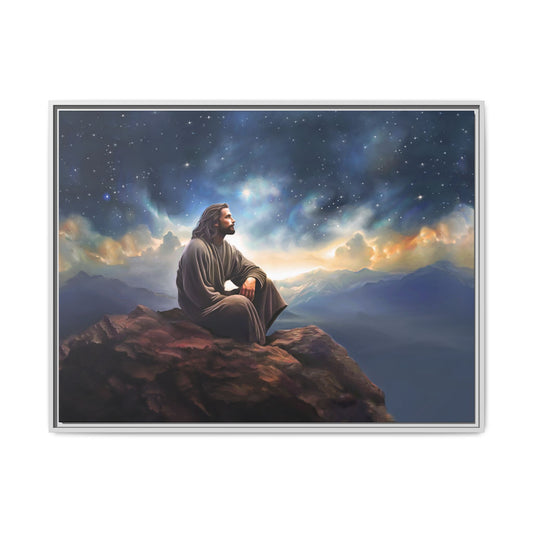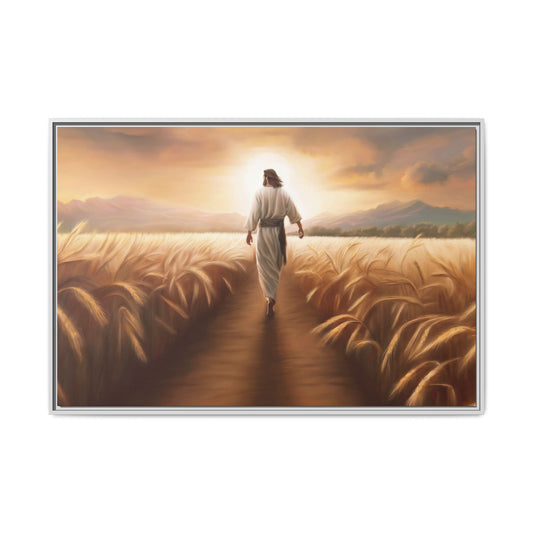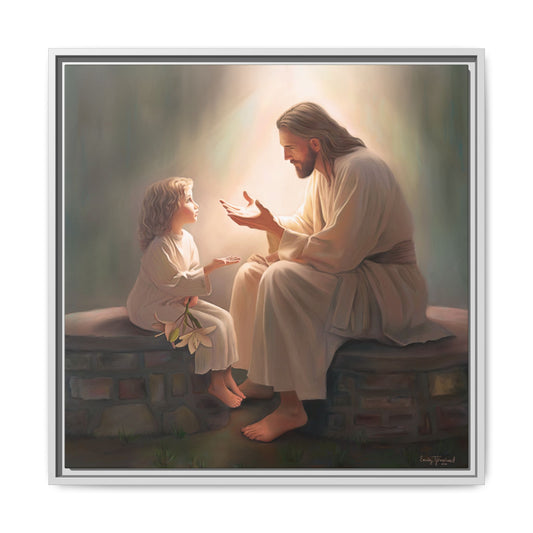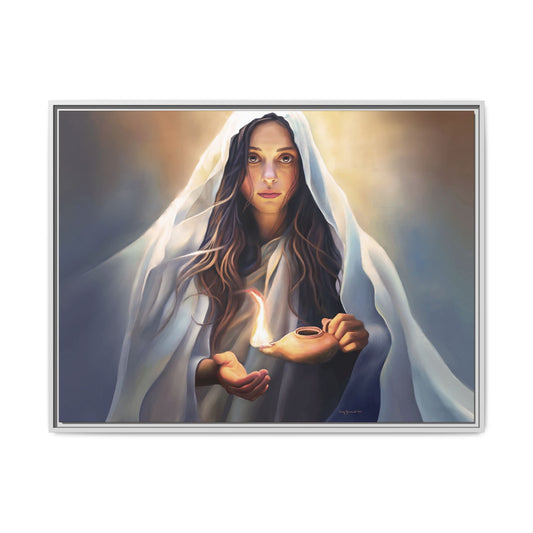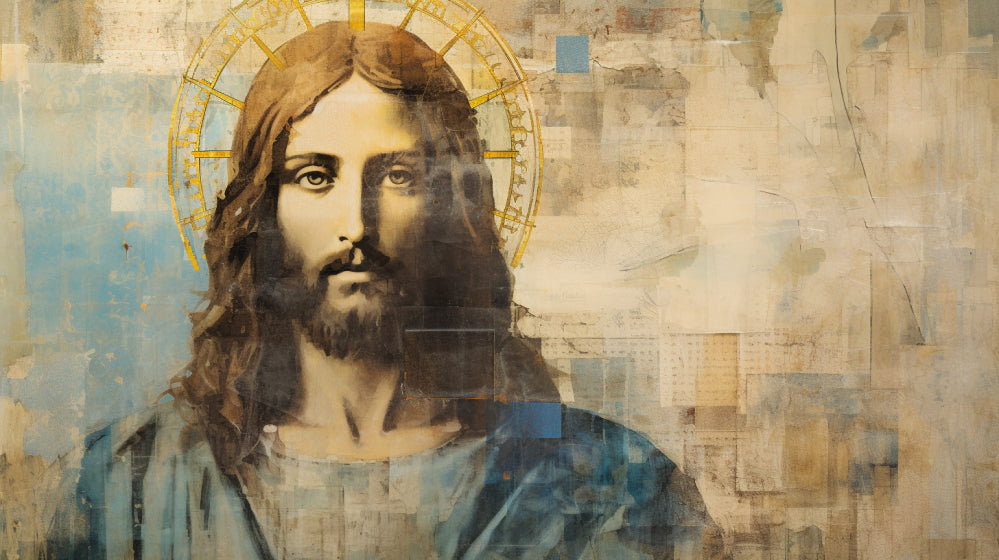
Traditional Jesus Painting
Share
We've all seen the traditional depictions of Jesus throughout history, from the earliest Roman paintings of a Caucasian, beardless youth to the Indian paintings of Jesus as an Indian sage. Like a patchwork quilt, these pictures of Jesus reflect the diverse cultures and beliefs that have been weaved together over the centuries. In this article, we will explore the traditional paintings of Jesus, looking at images from the Levant, Armenia, Scotland, India, China, the Philippines, Africa, and more. We will gain a deeper appreciation for the varied ways Jesus has been represented in the past, and examine the spiritual significance of traditional Jesus portraits for our faith.

These scriptural references, enriched with context, offer a pathway to understanding how the traditional depictions of Jesus have been shaped by key moments and aspects of His life as recorded in the Bible, serving as a bridge between historical faith and contemporary devotion. Our Lord has been portrayed in many ways. In the East, Jesus was portrayed as an Indian sage, Chinese holy man, or African man, each reflecting the culture in which He was depicted. Such depictions provide a powerful witness of Christ's divinity and are an important part of Christian worship.
Our Lord has been portrayed in many ways. In the East, Jesus was portrayed as an Indian sage, Chinese holy man, or African man, each reflecting the culture in which He was depicted. Such depictions provide a powerful witness of Christ's divinity and are an important part of Christian worship. We hope that the reader will gain an appreciation for how Jesus has been traditionally depicted. We also hope to broaden artistic possibilities so that heavenly things are more freely expressed through art so that perhaps we might be the more edified as we progress heavenward.
We hope that the reader will gain an appreciation for how Jesus has been traditionally depicted. We also hope to broaden artistic possibilities so that heavenly things are more freely expressed through art so that perhaps we might be the more edified as we progress heavenward. 


 Recent images have introduced more diversity and reflect the evolving view of God's image. Through these depictions, we see the changing face of Jesus over the years while still recognizing Him as the divine figure of God.
Recent images have introduced more diversity and reflect the evolving view of God's image. Through these depictions, we see the changing face of Jesus over the years while still recognizing Him as the divine figure of God. 




 From Syrian to Indian to Chinese images, we recognize that many distinct cultural heritages contribute to the richness of Jesus' legacy. We can also find books and videos that explore the diversity of Jesus depictions. By embracing the beauty of cultural diversity in Jesus art, we can gain a richer understanding of our faith.
From Syrian to Indian to Chinese images, we recognize that many distinct cultural heritages contribute to the richness of Jesus' legacy. We can also find books and videos that explore the diversity of Jesus depictions. By embracing the beauty of cultural diversity in Jesus art, we can gain a richer understanding of our faith. Diversity of artistic syle and cultural background can also inspire us to be more accepting and appreciative of one another.
Diversity of artistic syle and cultural background can also inspire us to be more accepting and appreciative of one another.  Here are some ways we can promote respect and acceptance:
Here are some ways we can promote respect and acceptance:
 Traditional Jesus portraits may invoke reverence and worship. By looking at the image of Jesus, we might reflect on his teachings and gain a greater understanding of who He is.
Traditional Jesus portraits may invoke reverence and worship. By looking at the image of Jesus, we might reflect on his teachings and gain a greater understanding of who He is.  Here are 5 ways traditional Jesus portraits can create a spiritual connection:
Here are 5 ways traditional Jesus portraits can create a spiritual connection:




Key Takeaways
- Different critical viewpoints approach the Bible differently, with historical criticism comparing the New Testament to contemporary documents and textual criticism aiming to discover the oldest and most authentic manuscripts.
- The Restoration, including Joseph Smith's First Vision and the Book of Mormon, provides a powerful witness of Christ's divinity, offering insights beyond traditional biblical sources and confirming the divinity of Jesus and the New Testament.
- Other documents exist which add additional testaments to further support the reality of Jesus as the Christ.

Traditional Jesus Painting: What is in the Scriptures?
Within the words of scripture we can find the roots of the enduring images and roles that have come to define Jesus in the collective imagination of the Christian faith: Luke 2:7: 'And she gave birth to her firstborn, a son. She wrapped him in cloths and placed him in a manger because there was no guest room available for them.' The nativity scene, centered on Jesus's humble birth in a manger, has become a cornerstone of Christian iconography, symbolizing His humility and God's proximity to humanity. Matthew 3:16-17: 'As soon as Jesus was baptized, he went up out of the water. At that moment heaven was opened, and he saw the Spirit of God descending like a dove and alighting on him. And a voice from heaven said, "This is my Son, whom I love; with him I am well pleased."' The baptism of Jesus by John the Baptist, marking the beginning of His public ministry, is a pivotal moment depicted in traditional Christian art, emphasizing His divine sonship and mission. John 13:4-5: 'So he got up from the meal, took off his outer clothing, and wrapped a towel around his waist. After that, he poured water into a basin and began to wash his disciples’ feet, drying them with the towel that was wrapped around him.' The foot washing scene, depicting Jesus's lesson in humility and service to His disciples, has been a powerful image in Christian art, illustrating His role as a servant leader. Luke 22:19-20: 'And he took bread, gave thanks and broke it, and gave it to them, saying, "This is my body given for you; do this in remembrance of me." In the same way, after the supper he took the cup, saying, "This cup is the new covenant in my blood, which is poured out for you."' The Last Supper, where Jesus institutes the Sacroment, is a central event in Christian tradition, celebrated and depicted across centuries as a sacrament of His sacrifice and presence. Matthew 28:5-6: 'The angel said to the women, "Do not be afraid, for I know that you are looking for Jesus, who was crucified. He is not here; he has risen, just as he said. Come and see the place where he lay."' The Resurrection is the cornerstone of Christian faith, with traditional depictions focusing on the empty tomb and appearances of the risen Christ, affirming His victory over death and promise of eternal life. John 10:11: 'I am the good shepherd. The good shepherd lays down his life for the sheep.' This imagery of Jesus as the Good Shepherd has been a comforting and beloved depiction throughout Christian history, symbolizing His care, guidance, and the protection He offers to His followers. Revelation 1:12-16: 'I turned around to see the voice that was speaking to me. And when I turned I saw... someone like a son of man, dressed in a robe reaching down to his feet and with a golden sash around his chest. The hair on his head was white like wool, as white as snow, and his eyes were like blazing fire.' The vision of the glorified Christ in Revelation has inspired awe-inspiring portrayals of His divine majesty and eternal kingship, reinforcing His role as the judge and redeemer at the end of time. Through these scriptures, we see the foundational events and teachings of Jesus's life that have come to embody the "Traditional Jesus" in Christian art, liturgy, and theology, providing imagery and meaning that continues to inspire and guide the faithful.These scriptural references, enriched with context, offer a pathway to understanding how the traditional depictions of Jesus have been shaped by key moments and aspects of His life as recorded in the Bible, serving as a bridge between historical faith and contemporary devotion.
Traditional Depictions of Jesus in Art
We explore the traditional depictions of Jesus in Christian art. The importance of Jesus portraits in worshipful expressions of art. How have traditional Jesus paintings served as powerful expressions of faith and worship? Throughout history, religious art has played an important role in expressing devotion. Jesus portraits, in particular, have been used to convey the Son of God as a divine figure in human form. Such sacred works of art have been used to convey strength, grace, and divine love. They also serve to remind us of the hope of salvation through faith. Traditional Jesus paintings provide a visual representation of faith in ways that words alone cannot. They help to bring the message of the gospel to life in personal and meaningful ways. With their colors and symbolism, they remind us of Jesus' divine mission and our relationship with him. In this way, traditional Jesus paintings serve as powerful expressions of faith and worship. Our Lord has been portrayed in many ways. In the East, Jesus was portrayed as an Indian sage, Chinese holy man, or African man, each reflecting the culture in which He was depicted. Such depictions provide a powerful witness of Christ's divinity and are an important part of Christian worship.
Our Lord has been portrayed in many ways. In the East, Jesus was portrayed as an Indian sage, Chinese holy man, or African man, each reflecting the culture in which He was depicted. Such depictions provide a powerful witness of Christ's divinity and are an important part of Christian worship. We hope that the reader will gain an appreciation for how Jesus has been traditionally depicted. We also hope to broaden artistic possibilities so that heavenly things are more freely expressed through art so that perhaps we might be the more edified as we progress heavenward.
We hope that the reader will gain an appreciation for how Jesus has been traditionally depicted. We also hope to broaden artistic possibilities so that heavenly things are more freely expressed through art so that perhaps we might be the more edified as we progress heavenward. 
Early Christian Art: Evolving Depictions of Jesus
As we explore the historical context of Jesus portraits, we observe an evolution in the way Jesus was depicted in early Christian art. From Romans to Armenians to Ethiopians, each culture's interpretation of Christ was unique. Themes of divine vitality, Semitic features, traditional father figures, Gaelic looks, Indian sages, Chinese holy men, African features, and Filipino Catholicism all appeared in various works. These images tell a story of a tradition that has embraced and celebrated Jesus' divinity throughout the centuries:- Romans depicted Jesus as a Caucasian, beardless youth
- Syrians portrayed Him as tall and dark-skinned
- Armenians viewed Jesus as a traditional Armenian father-figure
- Irish images showed Him with curly red hair and bright green eyes
- Indian paintings from the 9th century showed Jesus as an Indian sage
- Chinese images of Jesus often portrayed Him as a Chinese sage

Popularization of Traditional Jesus Portraits in Western Culture
Representing hope, love, and Christian values, these works of art are highly symbolic and serve as visual reminders of Jesus' life and teachings. Popularized by the Byzantine and Renaissance artists, the traditional Jesus portrait has become an iconic image of faith in Western culture. Used by painters, sculptors, and other creative professionals, the traditional Jesus portrait is a versatile tool for artistic expression. It can be represented in a variety of settings, including churches and homes, where it serves as a reminder to reflect on and to do God's will. Interpretations of the portrait can vary based on the artist's perspective, allowing for a range of artistic styles and interpretations. Depictions of Jesus in art and culture have become a recognizable symbol of faith, resonating with believers and non-believers alike.
Examining Historical and Geographical Contexts
By examining the historical and geographical contexts, it becomes evident that the traditional Jesus portrait depicts Him as a Middle Eastern man. The Holy Land, the cradle of Christianity, was where Jesus began His ministry and was later crucified. John the Baptist was a Middle Eastern figure, and Jesus was from the same region- in fact, they were cousins. During this time, portraits had to be realistic and reflective of the culture. Thus, the traditional Jesus image is of a Middle Eastern man: olive skin, bushy hair, and a thick beard. Images of Jesus today, however, may vary depending on the culture. Still, the underlying meaning remains the same: Jesus was a man who walked on Earth, fulfilling His holy mission- to reveal the love of God to all.The Use of Symbolism in Depicting Jesus' Physical Features
Symbols like a halo and a white robe are often used to denote Jesus' physical features in traditional Jesus paintings. These symbolic elements represent Jesus' divine life, His book of teachings, and many aspects of His sacred mission. Additionally, a dove may be used to represent His purity, a lamb to represent His meekness, a cross to represent His sacrifice, and a crown of thorns to represent His sufferings. Recent images have introduced more diversity and reflect the evolving view of God's image. Through these depictions, we see the changing face of Jesus over the years while still recognizing Him as the divine figure of God.
Recent images have introduced more diversity and reflect the evolving view of God's image. Through these depictions, we see the changing face of Jesus over the years while still recognizing Him as the divine figure of God. 


The Focus on Jesus' Teachings, Not His Physical Appearance
Traditional paintings of Him focus on His teachings and timelessness, not His physical appearance. Thus, these paintings capture His good, free, and learnable message, rather than an attempt to make Him appear in a certain set or ridged way.

Respecting Different Cultural Depictions of Jesus
We should respect and appreciate the diversity of global Jesus portraits, recognizing the beauty and richness of different cultural interpretations and allowing them to foster a sense of unity among believers. This encourages us to embrace and celebrate the many different ways of depicting Jesus, without having to limit ourselves to a single image. From Syrian to Indian to Chinese images, we recognize that many distinct cultural heritages contribute to the richness of Jesus' legacy. We can also find books and videos that explore the diversity of Jesus depictions. By embracing the beauty of cultural diversity in Jesus art, we can gain a richer understanding of our faith.
From Syrian to Indian to Chinese images, we recognize that many distinct cultural heritages contribute to the richness of Jesus' legacy. We can also find books and videos that explore the diversity of Jesus depictions. By embracing the beauty of cultural diversity in Jesus art, we can gain a richer understanding of our faith. Diversity of artistic syle and cultural background can also inspire us to be more accepting and appreciative of one another.
Diversity of artistic syle and cultural background can also inspire us to be more accepting and appreciative of one another.  Here are some ways we can promote respect and acceptance:
Here are some ways we can promote respect and acceptance:
- Acknowledge the beauty of differences in Jesus' depictions
- Research the cultural background behind different depictions
- Celebrate the diversity of interpretations of Jesus
- Respect everyone's views on the subject
 Traditional Jesus portraits may invoke reverence and worship. By looking at the image of Jesus, we might reflect on his teachings and gain a greater understanding of who He is.
Traditional Jesus portraits may invoke reverence and worship. By looking at the image of Jesus, we might reflect on his teachings and gain a greater understanding of who He is.  Here are 5 ways traditional Jesus portraits can create a spiritual connection:
Here are 5 ways traditional Jesus portraits can create a spiritual connection:
- They can be used as visual aids for meditation and contemplation.
- They're tangible reminders of the presence of God in our lives.
- They can provide comfort and hope in times of suffering and hardship.
- They can be a source of inspiration and motivation to live a life of faith.
- They're reminders of the love of Jesus for all humanity.

Maintaining a Connection to Christian Tradition
As we strive to maintain a connection to our Christian tradition, traditional Jesus portraits continue to hold a special place in contemporary society. These images provide a tangible reminder of our faith and the divine figure which is its foundation. Visual representations of Jesus serve many purposes in our lives, including:- Affirming our beliefs
- Strengthening our connection to God
- Reaffirming the story of faith and the importance of doing the will of God
- Providing a source of inspiration
- Encouraging us to live a life of holiness

Using Art to Deepen Faith and Reflect on Jesus' Teachings
By studying Jesus portraits, we can gain insight into the teachings of Jesus and deepen our faith. These works of art are a powerful way to connect with the divine and reflect on timeless messages. By looking at Jesus through the lens of painting, we can appreciate the diversity of interpretations. Through art, we can explore the nuances of Jesus' teachings and contemplate how they're relevant to our lives today. By engaging with traditional Jesus portraits, we can gain a richer understanding of the faith and apply it to our lives.


